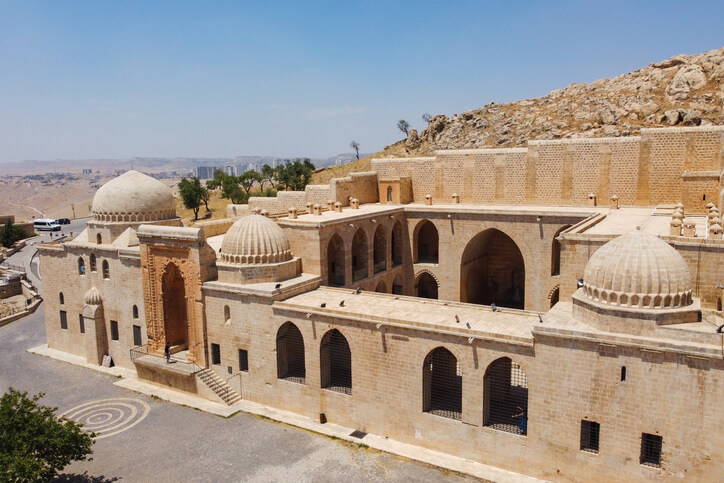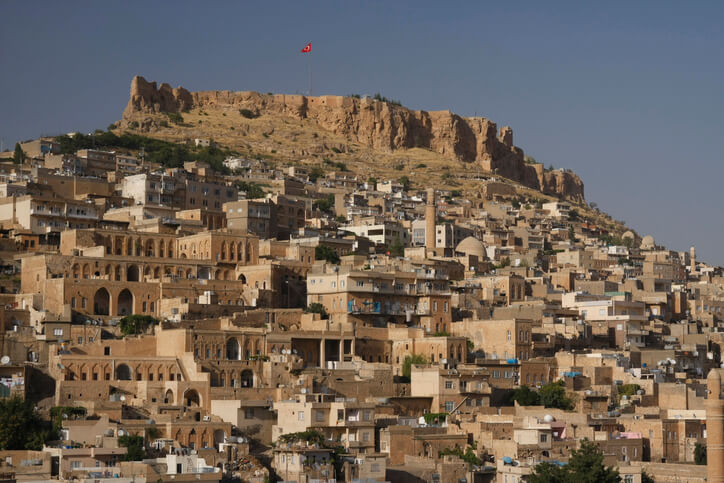İçindekiler

If you always wanted to know where Mardin is in Turkey, the historic city is located in the southeast of the country, close to the border of Syria. It overlooks the scenic plains of Mesopotamia, near the Tigris River.
Crowned by the ruins of a medieval Roman citadel, the UNESCO World Heritage city is primarily known for its limestone Artuqid architecture dating back to the 1100s.
Mardin has been home to myriad cultures and religions throughout the centuries, remnants of which can be seen while wandering along pretty streets, through bazaars, and visiting mosques, madrasas, and churches.
History of Mardin

In the 4th century, Mardin, Turkey was a settlement for the Syriac Christians, and known as Mount Izala. When the Romans arrived, they changed its name to “Marida” which translates in Aramaic to “fortress”.
In 640, the city was captured by a Muslim commander, and afterwards its identity changed hands on multiple occasions until it came under the rule of the Artuqid dynasty in the early 1100s.
During this transformational period, several of Mardin’s prominent landmarks were built, many of which are still evident today. The Artuqids remained in the city until the early 1400s, only leaving after being conquered by the Mongol Empire.
During the medieval era, Mardin was home to many different religions, and when the Ottomans arrived in the 1500s, the city remained peaceful for some time. The cultural diversity and welcoming atmosphere of those days can still be experienced by travelers visiting today.
Architecture of Mardin

Many of Mardin’s buildings are constructed from yellow limestone or sandstone. The stones were easy to shape for construction and could easily be sourced from the Mesopotamia plains. The architecture mostly derives from the Artuqid dynasty which ruled eastern Anatolia, Northern Iraq, and Syria, between the early 1100s and early 1400s.
The Artuqids left many remnants of their occupation behind in Mardin, which can be seen in etchings, carved figurines and inscriptions in walls and stones, and in the metalwork of the door handles. Impressive examples of such architecture can still be seen today at the Grand Mosque and Sultan Isa Medrese.
Historic Landmarks of Mardin

Mardin, which has kept its natural past and fostered several civilizations, has a wide variety of places to visit in Mardin for visitors. Due to Mardin’s historic culture and mystic atmosphere, these destinations offer tourists a unique experience.
The main historic landmarks of Mardin are Sultan Isa Medrese (Zinciriye Medresesi), Grand Mosque (Ulu Cami), and Kasimiye Medrese which are mentioned in the Mosques and Madrasas section below. However, there are also several more historical structures which shouldn’t be overlooked.
Sakip Sabanci Mardin City Museum is hidden inside a former barracks, displaying the culture and history of Mardin – with the lower floor telling stories through the medium of photography and artwork.
Mardin’s Old Post Office served as a residential home prior to becoming the city’s sorting center in the 1950s. Some sections of the building are open to visitors, plus, there’s a café on the upper floor with amazing views.
Mardin Bazaar can also be classed as a historic landmark. The city is famous for its wool, cotton, and sesame trade and for handmade organic soaps made from wild pistachio and pure virgin olive oil. Visitors can also find metalworkers, historic bath houses and donkey saddlers here. The bazaar also makes it possible for visitors who are unsure about what to eat in Mardin to experience Mardin cuisine with various restaurants.
Deyrulzafaran Monastery (also known as Mor Hananyo) is located a few kilometers outside Mardin on the site of a temple dedicated to Shamash, a Mesopotamian sun god. It is one of the most popular tourist attractions in the area and guided tours are available to view the impressive complex of churches, courtyards, and arcades. In order to more properly organize your trip to Mardin, you may also use the “Mardin Travel Guide“.
Mosques and Madrasas

The Grand Mosque or Ulu Cami is perhaps the most impressive exterior site in Mardin and can be seen from throughout the city. Originally constructed in the Artuqid period during the 1170s, (although rebuilt several times since), it’s easily recognizable from its fluted dome and decorative stone cut minaret.
Nearby, Sultan Isa Medrese, also known as Zinciriye Medresesi, dates to 1385. It was constructed as a madrasa – an Islamic college for teaching religious scripture. Visitors can explore the study rooms, the prayer room, see the decorative vaults and Kufic calligraphy, plus, visit the rooftop for exceptional views of the city and plains beyond.
Southwest of the center, Kasimiye Medrese – a former madrasa, stands majestically in sandstone at around 975 meters elevation. This, another exceptional example of local architecture, was built in the mid-1400s. Highlights include the arched colonnades, courtyard pool, and the rooftop panoramas.
Churches

Mor Behnam or Church of the Forty Martyrs dates to the 6th century and is one of seven Syriac Orthodox churches in Mardin. The church contains beautiful inscriptions and motifs around the exterior walls and a pretty bell tower. The weekly service is held in Aramaic Christian (the language of Jesus), as it has been for several centuries.
One church with amazing vistas is Mor Şmuni Kilisesi, constructed around the same time. It is dedicated to Mort Shmuni – punished with her sons for refusing to convert from her Christian faith. The building, surrounded by a sandstone wall, was renovated in the early 1100s and includes a more recent school and bell tower.
Saint Hirmiz Chaldean Church is run by a single family in Mardin. This charming church boasts an impressive exterior and atmospheric stone interior, with a principal brick dome roof, altars, tombs etched with ancient scriptures, and abundant historic artworks.
Houses

Mardin’s houses are a deep shade of burnished brown, carved into the rocky hillside. They are designed on multiple levels with terraces – each one angled for an uninterrupted view of the city and countryside.
The larger limestone dwellings comprise courtyards and upper levels accessed via staircases, and some of the older Ottoman era properties were constructed with separate male and female quarters.
The doors are of particular interest, crafted with intricate carvings and motifs of animals and fruit, with the door knockers are shaped to resemble the beak of a bird.
If you wish to know how far is Mardin from Istanbul and how to get to Mardin, Turkey, you can access the city in around 16 hours by car from Istanbul, travel by bus, or take a short flight from Istanbul Sabiha Gokcen International Airport to Professor Dr. Aziz Sancar Airport, 17 kilometers away.It takes 1 hour and 30 minutes to reach Mardin from Istanbul with Pegasus.
You may plan your trip with Pegasus Airlines to take advantage of cheap flights to Mardin!






